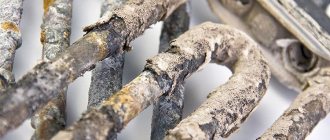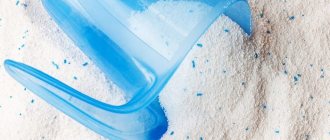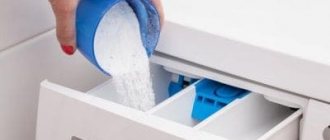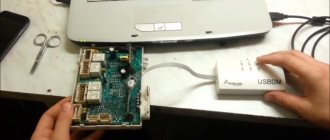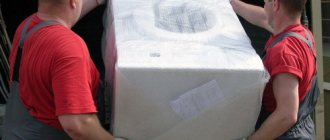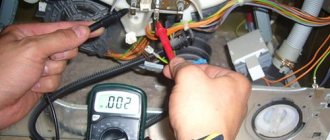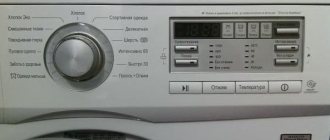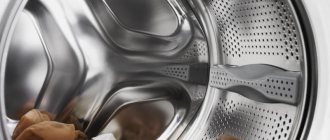Today, a washing machine can be found in almost every home. It saves a lot of time and makes our life easier. But this hardworking assistant periodically needs to be cleaned to remove scale and unpleasant odors. To remove them, experts recommend using advertised chemical cleaners. We would like to draw your attention to household products that are easy to use at home. An indispensable assistant in this matter is an effective natural and, importantly, inexpensive remedy, proven over decades - vinegar! Its main advantages:
- accessibility, always “at hand”;
- antibacterial and disinfectant properties;
- perfectly removes scale:
- safety for both humans and the parts of the washing machine.
In this article we will tell you how to quickly clean an automatic washing machine with vinegar. It will easily and carefully free all parts inside the machine from dirt.
Causes of scale and unpleasant odor
The main reason for the formation of scale: “hard” water containing calcium and magnesium salts dissolved in it. During washing, calcium and magnesium compounds decompose into carbon dioxide and insoluble sediment - lime deposits that stick to machine parts and heating elements. This is how scale forms on the heating element. Unfortunately, the quality of our tap water makes it impossible to prevent the appearance of limescale.
Colonies of microorganisms and mold are the source of unpleasant odors. Comfortable conditions for their reproduction:
- Mold on the drum and heating element appears at high humidity and low temperature. “Short” washing programs at temperatures below 40 degrees should be avoided as much as possible;
- Crumbs and pieces of paper remaining in clothing pockets sticking to the walls of the drum serve as food and a basis for colonies of bacteria and mold. It is imperative to remove these small particles from the drum and wipe its surface;
- Residues of powder and conditioner in the detergent container, as well as water at the bottom of the drum, are a favorable environment for the growth of bacteria and mold. After washing, these parts must be wiped dry;
- Mold may appear on the damp rubber sealing ring around the hatch - after finishing washing, the ring must be wiped of moisture.
- Small particles of dirt and pieces of rust from the water settle on the filter and form the basis for the accumulation of bacteria and mold. It is necessary to regularly clean the filter and promptly replace it with a new one.
NOTE! To increase the service life of the device, immediately after washing clothes, rinse and wipe dry the inner surface of the tank, the detergent container, and regularly clean the filters. It is better to keep the loading hatch door slightly open for natural ventilation in the washing machine.
But places such as heating elements with a deposit of washing powder and scale formed on them, and other surfaces of the internal parts of the machine are inaccessible for manual cleaning and rinsing.
Regular table vinegar will help solve this problem without much difficulty.
Is it possible to clean a washing machine with folk remedies?
High humidity, low temperature, and the adhesion of pieces of dirt inside the device become a favorable environment for the growth and reproduction of microorganisms and fungi. The washing machine is a breeding ground for pathogenic flora, which negatively affects the health of the entire family.
Acetic acid has universal abilities to combat scale and mold:
- The ingredient in homemade dishes has a minimal negative impact on the walls of the machine’s appliances. When using a low-concentration vinegar solution, no damage to parts is observed.
- The substance kills microorganisms. It prevents pathogenic bacteria from getting on human clothing.
- Acid kills mold. Fungi die after contact with the substance.
- Reduces the layer of scale on the walls of washing machine parts. With regular use, lime deposits are completely cleaned.
- The home remedy suppresses the unpleasant odor caused by bacteria and fungi inside. The scent from the cleaning agent will dissipate after a few washes.
Many years of experience in using acetic acid shows that it is as effective as expensive household chemicals.
How to clean a washing machine with vinegar - step-by-step instructions
Over many decades, cleaning a washing machine with vinegar has shown its effectiveness, and the results are not inferior to rather expensive household chemicals. Experienced housewives use this method not only to save money. They are also attracted by its ease of use.
Step-by-step instructions will help you verify this using the example of cleaning a washing machine with 9% vinegar:
- Before starting work, make sure that the washing machine drum is empty.
- Pour a glass (200-250 ml) of 9% table vinegar into the powder compartment.
- Select the longest washing program with maximum temperature (90-95 degrees) and start it.
- When the water in the machine heats up (after about 20-25 minutes), stop the program by pressing the “Pause/Stop” button and leave for 1–1.5 hours.
- Turn on the machine by pressing the “Start” button to end the wash cycle.
- Clean the drain filter from scale.
- Dissolve 50 ml of vinegar in a liter of water and wipe the drum, rubber sealing ring with the resulting solution, and remove dirt from the surface of the door glass.
- To completely rinse the internal parts from residual acetic acid and scale, run the machine again, but for the shortest cycle with intensive rinsing turned on. No need to add any cleaning agents or detergents!
- When the process is finished, be sure to clean the drain filter again.
- Finally, wipe the drum, rubber o-ring, and hatch glass dry.
To enhance the impact on mold, you can clean your washing machine with vinegar and soda. In this case, a glass of 9% table vinegar is poured into the drum. A soda solution (1 tablespoon and 100 ml of water) is placed in the washing powder compartment. Then proceed according to the instructions, starting from point 3.
NOTE! Only 9% vinegar is used for descaling. The concentration of vinegar essence is 70%. Its use in its pure form can damage machine parts, especially plastic and rubber ones.
The easiest and most memorable rule for diluting the essence with water to obtain a 9% solution of acetic acid: the ratio with water is 1:7. In our case, from 30 ml of vinegar essence 70% and 210 ml of water (30 * 7) we get 240 ml of 9% vinegar.
Removing scale
Scale – lime deposits. They are formed when water is heated and settle on the metal parts of the SMA. Essentially, scale is hardness salts. Everyone knows from a school chemistry course that to neutralize such compounds, it is enough to use an acid that reacts with scale and dissolves it. Ordinary 9% vinegar, found in every home, is such an acid.
How to descale a washing machine with vinegar
Vinegar does an excellent job not only of removing lime deposits, but also of unattractive odors. It perfectly kills bacteria (vinegar is even used to sanitize surfaces in food factories). Some housewives add a glass of vinegar when washing kitchen towels.
Add a glass of vinegar when washing kitchen towels - you will love the results! "
Let's look at the pros and cons of vinegar (in terms of its use for cleaning SMA).
Let's start with the advantages:
- Affordable price.
- Removes both scale and mold from the washing machine.
- When used correctly, it does not damage the internal parts of the equipment. But do not use concentrated acetic acid undiluted. This may damage the sealing rubber.
Detailed instructions for using vinegar to remove hard lime deposits in a washing machine:
- Remove all items from the loading hatch as they may be damaged by acetic acid.
- Use a nine percent vinegar solution. If you have a seventy percent essence, mix it with water in proportions of 1 to 7. To prevent the acid from harming the delicate skin of your hands, wear protective gloves.
- Pour half a cup (125 ml) of the solution into the powder niche.
- Run the SMA on the longest setting using high temperature.
- After the water starts heating, wait a little and press pause, then wait about 90 minutes.
- Start the SMA again and wait for the wash to finish.
- Prepare a weakly concentrated solution (mix 0.05 liters of 9% vinegar with 1000 ml of water). Treat the rubber and drum with this mixture.
- Run the appliance in rinse mode to remove vinegar and remaining limescale.
- Pull out the drain filter and wash it.
- Wipe the drum, rubber, and glass of the hatch.
Descaling a washing machine with soda and vinegar
To get better results, you can use baking soda and vinegar at the same time to remove solid deposits. You will need 500 ml of table vinegar and 2 heaped teaspoons of baking soda.
How to remove musty smell
If an unpleasant musty smell appears in the washing machine, this should serve as a signal that the internal parts of the machine need cleaning. But first of all, you need to establish the cause of the smell:
- Rare use of the machine, lack of natural ventilation due to a tightly closed hatch;
- Storing dirty clothes in a drum;
- Remains of water at the bottom of the drum, contamination of the tray or detergent supply channel with residues of powder or conditioner;
- Dirty drain hoses, filter
Vinegar combined with baking soda will help remove the smell at home. This method is described in the previous section.
NOTE! The smell may be caused by poor sewerage.
How to proceed?
This type of washing is performed in idle mode, and vinegar is not mixed with soda: a pre-prepared mixture of soda and water is added to the loading hopper of the washing machine, and vinegar is added to the tank. After that, set the longest mode and maximum temperature. Upon completion, repeat the steps from the previous instructions, starting from step 8.
How to descale your washing machine with soda and vinegar
Cleaning the powder container
The detergent container requires more frequent cleaning.
The narrow channel for supplying detergents quickly becomes clogged with dense crumbs of washing powder, onto which thick conditioner sticks. In conditions of high humidity, colonies of microorganisms and mold form on the external and internal walls of the container.
Step-by-step instructions for cleaning the container:
- Pour warm water and a glass (250 ml) of 9% vinegar into a deep container.
- Leave for several hours (at least 2).
- Then use a brush (you can use a toothbrush) or a stiff sponge to remove any remaining powder and dirt.
- Rinse the container well with running water and wipe dry.
Important! Choose a container so that the container is completely submerged in water.
If traces of mold are visible on the walls of the container, additional treatment can be carried out:
- Apply a mixture of soda and water (ratio 1:1) to the walls of the tray.
- Leave for 2 hours.
- Remove plaque and traces of mold with a brush or sponge.
- Rinse the container well with running water and wipe dry.
Important! When we add vinegar to the washing machine in low concentrations (9%), it does not harm external surfaces or internal parts. But, in order to avoid prolonged contact of acid with rubber and plastic parts, after cleaning it is necessary to rinse them well with water and wipe them.
What causes scale and dirt to form in a washing machine?
Sand and dirt enter the washing machine through tap water or through dirty laundry. But scale forms when heating and rinsing clothes with hard water, which contains metals and salts.
The scale itself has a negative impact on the internal parts of the automatic machine; when accumulated, it destabilizes the balancing of the drum. And also in the case when it envelops the heating element, there is a significant decrease in the performance of the element, which leads to the burnout of the fuse and heating element.
Prevention
It is always easier to prevent a problem than to fix it. To ensure that your machine serves you for a long time and without failure, we suggest that you adhere to the following recommendations.
- Use powder, conditioner, bleach in the required quantity specified in the instructions. Excess detergents settle on the parts of the washing machine.
- After each wash, wipe the rubber o-ring, drum, and hatch door glass dry.
- Rinse the detergent tray and wipe the recess into which it is inserted.
- Before placing laundry in the drum, remove any excess items from the pockets.
- Do not store dirty laundry or washed laundry in the machine. take it out immediately.
- Clean the drain hose filter regularly and replace it as necessary.
- At least once a month, wash your clothes at maximum temperature.
- Avoid using low quality powders.
- For natural ventilation and evaporation of excess moisture, always keep the hatch door ajar.
- At least once every 6 months (more often with very hard water) you need to clean the washing machine with vinegar.
By following these simple tips, you will not encounter any unpleasant consequences for your machine.
Advantages and disadvantages of the method
Before you start, check out the pros and cons of using vinegar to descale your washing machine.
The positive aspects of this method include:
- high efficiency . Due to its chemical activity, acetic acid easily copes with lime, dissolving it to the smallest particles, which are then easily washed off with plain water;
- sanitary treatment . Vinegar is a good disinfectant, so it is used not only to remove scale, but also to remove mold, fungal microorganisms and bacteria;
- getting rid of unpleasant odor . Vinegar completely neutralizes odors that invariably arise during long-term operation of the washing machine;
- availability . Acetic acid is much cheaper than various cleaning products and is always on hand;
- safety . If the recommended proportions and rules of use are observed, vinegar does not have a harmful effect on the parts of the washing machine.
Among the disadvantages, the following factors can be noted:
- Strong smell . However, this side effect can be easily eliminated by running an additional rinse mode and opening the tank and tray for ventilation;
- risk of damage to rubber and silicone parts . As mentioned above, to eliminate this possibility, it is important not to exceed the concentration and not to clean household appliances too often.
Cleaning your washing machine with vinegar is an effective and proven way to combat plaque, mold and other contaminants. If you carry out the procedure according to all the rules, the risk of negative consequences will be minimal.
It is recommended to use vinegar to descale a washing machine no more than once every 3-6 months, optimally 2-3 times a year.
Cleaning the detergent container with acetic acid
It is equally important to keep the detergent container clean. After each wash, wipe it from the inside and remove dirt from the surface. If the container has not been cleaned for a long time and a large amount of scale and dirt has accumulated on it, use acetic acid.
Vinegar 9% is suitable for cleaning. Fruit types of acid are not suitable for the procedure because they have a lower concentration.
First, remove the detergent container from the washing machine. Place it in a deep container.
Pour enough vinegar into each hole in the container to cover the stains. To increase effectiveness, add baking soda to the holes after adding the preservative. After 2-3 minutes, pour boiling water over the acid. After two hours, pour the liquid out of the container and begin mechanical cleaning. Remove any remaining dirt with a sponge. Rinse the container, wipe with a rag or damp towels and place in the washing machine. It is recommended to wash the detergent drawer after each wash.
See how to properly clean a machine with acid:
How to replace vinegar when cleaning a machine?
Not only vinegar can be used to clean household appliances. There are several components found in every apartment. They will also cope with this task effectively.
The most common replacement options:
- Lemon acid. This component must be poured in an amount of 100-200 g (depending on the condition of the household unit) into the powder compartment or directly into the drum. The efficiency will be the same. Run a long wash with water heating to 90 degrees. When finished, check the drain filter and the rubber parts inside and, if necessary, remove any accumulated scale.
- Copper sulfate. The product is effective against unpleasant moldy odor and fungal infections. Its action does not harm the equipment. Before use, you need to dilute 30 g of vitriol in 1 liter of water. Treat the entire inside of the unit with the resulting solution using a sponge and leave for 24 hours. After the period has expired, the machine must be turned on to the washing mode, pouring any washing powder into the compartment. At the end of the procedure, carry out an additional rinse, and then wipe the inside with a dry cloth.
- Soda Ash. The difference between technical soda and baking soda is the acidity level - 11 units. You need to use soda ash carefully, because... it can cause skin irritation. The substance helps descale the washing machine much faster and more efficiently. For cleaning, it is enough to pour 50 g of the component.
Read more ► Water filter for a washing machine: is it necessary, which ones are used, the best softeners
Frequency of descaling the washing machine
The main thing that affects the rate of scale formation in a washing machine is the quality of the water entering the house. If the water has a high level of hardness and you often wash at a high heating temperature, then be sure that limescale deposits will not take long to appear. Therefore, try to find out the hardness of the water that flows from the tap in your house. Research by specialists has shown that active scale formation on the heater and internal surfaces of the machine begins when the water temperature reaches 75°C.
Do not rush to abandon programs that use high water heating. By completely eliminating washing at high temperatures, you will create favorable conditions for the appearance and proliferation of mold. Based on all the facts, it is necessary to determine the optimal frequency of descaling in each case individually. You can probably only find out about the appearance of plaque by disassembling the washing machine.
Guided by the level of water hardness and relying on the experience of specialists, you can follow the following cleaning frequency:
- once every two months - with very high water hardness and almost daily washing;
- once a quarter if the water is of medium hardness and the washing machine is used no more than three times a week;
- twice a year - with soft water and one wash per week.
It is possible to reduce the frequency of cleaning your washing machine if you take a number of measures. For example, install a special filter in the water supply system to the washing machine or use Calgon and similar products.
Step-by-step instructions for cleaning machine elements
It is best to clean the machine sequentially, paying attention to every detail. It is not necessary to use only baking soda. You can choose baking soda plus vinegar, baking soda plus citric acid, or lemon juice alone.
Drum and heating element
The drum is especially susceptible to contamination: when the laundry is scrolled, particles of plaque, paint from the fabric, torn threads - all this gets stuck in the holes through which the water drains. If you keep the machine closed at all times, the humid environment becomes an ideal place for bacteria to grow.
The heating element is a heating element, without which the machine will not be able to function. Over time, scale appears on it. The heating element fails. The car has to be taken for repairs.
To prevent such situations, clean the machine with vinegar and soda.
Also read: How to use soda to restore the whiteness of things: little tricks of housewives
Mix 250 g of baking soda, 0.5 liters of table vinegar, 250 ml of water. The result should be a homogeneous mass.
Prepare the car: remove any small items that may have been left behind. Remove the rubber cuff and wipe with a dry sponge to remove any remaining moisture.
Place the cleanser in a container designed to hold laundry detergent.
Select a program that includes rinse and spin. Start the machine. Set the temperature to 600C.
If you have hard water in your home, there is probably a lot of scale on the drum and heating element. Citric acid will cope with it. Your steps should be the same as in the previous case, but instead of a mixture of soda and vinegar, use citric acid. When loading a machine with 3 or 4 kg, 60 g of lemon juice is required. If the maximum load is 7 kg, you need 100 g of citric acid.
After finishing washing, open the machine. Wipe all accessible surfaces. Fold back the cuff and wipe it. Leave the machine open for a day to dry.
The washing machine drum may only appear clean - dirt accumulates on the back side
Cuffs and tray (dispenser)
Sealing rubber is one of the favorite places for bacteria to be located. Start washing it after you have run the machine “idle” with a cleaning agent, that is, when the drum and heating element are in order.
Apply a little baking soda or Pemolux to the sponge. You can use Domestos, Comet. After peeling back the cuff, wipe all visible surfaces with a sponge. Rinse off the cleanser.
The biggest challenge when cleaning the tray is getting it out. Pull it towards you until it stops. If you have an Indesit machine, pull the tray towards you and down, and then remove it completely.
If you have a machine of other brands (Bosch, Samsung), then pull out the powder receptacle until you see a blue part. You need to press on it and pull it towards you, supporting the dispenser.
When the tray is pulled out, there will be residues of washing powder and moisture. Remove these residues. Wipe the container with a sponge and a mixture of baking soda and vinegar.
You might be interested in: How to clean a microwave with baking soda in 5 minutes
Drain pump and filter
First you need to provide access to the filter. It is located at the bottom of the machine.
Before opening the filter, prepare a container into which the water will be drained. It is always located in this part of the machine, and its volume sometimes reaches up to 500 ml. To prevent water from dripping onto the floor, place a tray or baking tray (from the oven).
Also read: How to clean a bathtub using baking soda and vinegar at home
Open the drain pump using a screwdriver. You may find a lot of foreign objects that shouldn't be in the car. This is the fur of the cat or dog living in the house, the hair of all family members, threads from dresses and blouses, copper coins from pockets, and sometimes even torn buttons and peeled off rhinestones. All this, of course, needs to be shaken out.
The second filter is located on the inlet hose.
Without paying proper attention to cleaning it, you risk quickly damaging the machine. If the filter is clogged, it is impossible to draw water.
The machine should be cleaned every 2-6 months - depending on how often it is used
Turn off the cold water tap. There is an inlet hose at the top right of the machine body. Unscrew the hose nut counterclockwise. After this you will find a small filter. Take it out and rinse it using a toothbrush. Put it in place. Close the inlet hose.
Clean this filter once every six months. For other parts, the frequency should be more frequent - once every one to two months.
Let's pay attention to the body and door. Wipe the surface of the door and body with a sponge coated with Domestos. Remove any remaining product with a clean, damp sponge.
Also read: How to clean a sewer pipe with soda and vinegar at home
Signs you need cleaning
Often washing things in a machine does not lead to the desired results. Even after boiling, the laundry remains insufficiently clean and has an unpleasant odor.
Limescale, mold and other contaminants lead to malfunctions of the machine and deteriorate the quality of washing. Most often, plaque forms on the heating element.
Experts believe that you need to clean your washing machine using available products at least once every 6 months. But, if the device is used more often, you can clean it every 2-3 months.
Useful tips
If you follow a few simple recommendations when using an automatic washing machine, you will rarely need to clean the unit:
- The main cause of washing machine breakdowns is hard tap water with a high content of foreign impurities. To protect the internal parts of the machine from scale, it is recommended to install water filters. If this is not possible, you should use water softeners, for example, Calgon.
- In addition to chemicals, ordinary household products can help soften water. When washing, you can add baking soda to the detergent tray from time to time; it has a positive effect on the composition of the water and makes it less hard.
- In addition to scale, the automatic machine is damaged by fine dirt, which accumulates over time on the internal elements of the unit. Before washing, it is recommended to carefully check the pockets of clothing, as well as shake off items and brush them to remove small threads, hair, wool and dust particles.
- The most vulnerable parts of the washing machine are the sealing collar and the drain filter. Once every 2 months it is recommended to carry out a small cleaning of these elements. The cuff on the machine hatch can be regularly wiped with soapy water; the filter must be unscrewed and cleaned manually from accumulated debris.
When washing, you can use soda to soften the water, then scale will form more slowly
Important! It is recommended to disinfect a washing machine with vinegar no more than once every six months. With constant use of household solvent, the condition of the rubber elements will deteriorate, and the machine will, one way or another, require repair.
Cleaning the cuvette from plaque
Remove the detergent tray, being careful not to break the fasteners. Different models have different methods for removing the cuvette, so first consult the documentation for your washing machine.
Select a container that will completely fit the cuvette. Prepare a solution in a container by pouring 250 ml of 9% table vinegar with hot water. Place a tray there so that the solution completely hides it. Leave the cuvette in diluted vinegar for 5-8 hours and then clean the deposits with a sponge. After removing deposits and dirt, rinse the surfaces of the tray with clean water, wipe it dry with a cloth and return it to the washing machine.
To clean plaque, you can use an alternative method. Take baking soda, 9% vinegar and prepare a cleaning product from them. Mix the ingredients until you obtain a paste-like mass, which you apply to the areas covered with plaque. Wait three hours and clean the surface with a soft small brush, such as a toothbrush. After removing the deposits, rinse off any remaining cleaning agent and dirt, wipe the tray, and then insert it into the machine.
Why soda?
The fact that soda can be used for household purposes comes as a surprise to many, because many housewives are accustomed to buying special cleaning products in chemical stores. In fact, this powder has many possible uses. One of them is cleaning washing machines.
To understand why soda turns out to be an effective means of combating washing machine contamination, you need to understand the issue of their appearance. For some, it remains a mystery how it happens that ordinary things are washed, and such “garbage” appears in the form of plaque, scale and dirt. In addition, an unpleasant odor appears, which is somewhat reminiscent of the smell from the bathrooms.
The answer to the question is simple: the water we use for washing is to blame. Unfortunately, most housewives do not have special filters for cleaning, and they cannot provide absolute purification of the water. In addition, water hardness negatively affects the condition of the metal from which the equipment is made. Therefore, plaque accumulates both on the drum of the washing machine and on the heating element. If you do not start to fight its formation in time, this can lead to breakdown of the machine, and in some cases to its complete malfunction.
Soda tends to have a softening effect. This is useful when the main source of plaque formation is excessive hardness of the water used for washing. In addition, baking soda is chemically alkaline, so it can dissolve harmful acids and other contaminants. Baking soda also has bleaching properties, which improves the condition and appearance of the internal parts of the machine. Thus, soda is a universal remedy that can protect the washing machine from various types of contaminants and extend its service life.
